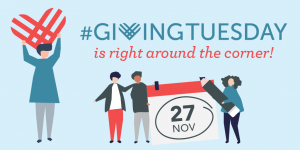Giving Tuesday, the social media darling and only global day of philanthropy, is just six weeks away. The highly anticipated online event has finally gained the traction necessary to have itself marked on most nonprofit fundraising calendars, however, that doesn’t mean that planning always begins when it should. In an effort to help improve your strategic thinking around Giving Tuesday and your end of year fundraising, we’re presenting you with three foundational elements of a plan that will prepare you for November 29th.
Integrate #GivingTuesday Into End of Year Fundraising
#GivingTuesday may have originated as a one-off fundraising event but as it’s grown, its revenue-generating power has helped the event take root as an integral part of most organizations’ year-end fundraising. That said, it seems logical to integrate Giving Tuesday into your overall end of year fundraising program. Though Giving Tuesday is largely about participation and small gifts, that doesn’t negate its value as part of a larger plan. We know from experience that an integrated approach to fundraising works. The proliferation of digital media in recent years along with shifts in donor behavior have presented fundraisers with unique challenges and opportunities alike. Individual marketing efforts should reinforce one another—not compete—to accomplish a singular goal.
Most nonprofits have an all-or-nothing mentality when it comes to communicating with donors for fear of being too aggressive. In the case of Giving Tuesday, the fear of over-asking or receiving an atypically smaller gift from regular donors gets in the way of their approach. Most studies show that donors want to engage us, just often in different ways. Integrating Giving Tuesday into your full program will enable you to capitalize on existing interest and excitement about your cause while leveraging audiences that have already been cultivated online.
Custom Campaign Pages and the Donor Experience
A campaign landing page can provide a really special and highly focused experience for your potential donors. Plus, if you’re integrating your Giving Tuesday campaign into your end of year fundraising program, this tool can be utilized well beyond one day (making it a worthwhile investment). By cutting out the clutter from both “competing” organizations and the information on your primary website, you’re better able to highlight the story that is the focus of your entire campaign. Custom landing pages also present the opportunity for organizations to provide a personalized and donor-centric experience where aspects of your campaign narrative and even your donation module’s ask string are tailored to the visitor. Note that you can offer up this personal portal to members of your constituency that you already know while utilizing a generic version of your landing page for new people you capture via social media or from social sharing.
It’s important to ensure that the giving process feels meaningful, not just on Giving Tuesday but throughout the entire year. You’ll want to consider the journey of the end-user, how they’ll move through your story to the point where they make a gift. Making your donors feel heroic throughout the process is key, so that donor-centric messaging is going to come in handy as you reinforce the importance of their gift at each stage of the game. By donor-centric we mean language that connects with a donor’s values and reminds these individuals that their support helps you make an impact whilst helping them achieve their philanthropic goals.
Broadcast Tangible, Quantifiable Goals
Fundraising goals are important for several reasons, the most obvious being the measurement of your organization’s success. Understanding where you’re succeeding and where you’re falling short will help you modify and optimize communications and marketing to drive results in the necessary areas (like response rates, average gift size, performance among segments, et al). The other side of the coin when it comes to goals is making those goals public. Why? When your general audience knows what you’re trying to achieve, they’re more able to celebrate in your success. After all, you can’t really do it without them.
It’s important to note, however, that whatever goal you choose to make public or to center your campaign around should be something that is both tangible and quantifiable in a reasonable sense. For example, you wouldn’t charge your audience with helping you increase the lifetime value of a donor. That’s a complicated metric that doesn’t include a logical connection to your mission or impact. You could, however, focus on increasing the participation of a specific segment (like young donors) — #participationgoals, amiright? You could be more specific and relate your goal to a desired area of impact, which can help increase potential search results of prospects looking to give to something specific. The major point here is including donors in your success and celebration in a way that connects them to your mission, your cause, your raison d’être. This is just another way to tell your story.
The Wrap Up
Hopefully these tips will get you thinking about #GivingTuesday now, and not after the fact. It’s important to make sure that your fundraising efforts are consistent and that your message is unified. INTEGRATE and use this day as a way to enhance more traditional forms of solicitation like printed appeals or e-mail campaigns. Make the time to develop strong communication plans, but with time and staff resources being limited for so many nonprofits we recognize that that’s not always an option. Hopefully this article and others on our blog can help you make the most of #GivingTuesday 2016.
You Might Also Enjoy:
+ 5 Ways to Put Your Donation Page to Work
+ 3 Things You Can Do Right Now for #GivingTuesday
+ 3 Ways Mission-Driven Infographics Are More Effective
Like what you see? Stay in touch!












